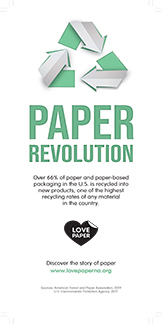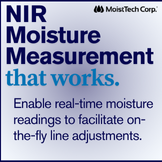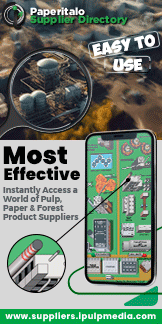New data reveals paper materials are a leading contributor to landfill tonnage, exceeding plastic and food waste.
THE BACKGROUND: PAPER IS MY PASSION, AND PAPER RECYCLING IS A SUCCESS
Before I dive into detail, I am taking a minute to say what this article is and is not. It is not a criticism of paper or paper recycling industries. It is an attempt to draw attention to data used to define paper landfilled and combusted or recycled and make efforts to standardize methodologies. For the past 20-plus years, I have served as a senior executive and part of the leadership teams for two leading paper, packaging and recycling companies globally. In addition to serving as president of their recycling divisions, I held other senior level roles. More recently, I formed Circular Ventures LLC, dedicated to helping both public and private entities with advisory services for improving both recycling and sustainable packaging.
Since forming Circular Ventures, I serve on three boards of organizations that promote paper or paper recycling and have a myriad of clients from private equity firms to solid waste districts, where paper is a primary focus. I am regularly solicited by news sources and publications to weigh in on various paper and paper recycling matters. Suffice it to say that paper packaging and recycling is my passion. I am a paper guy.
Why is it necessary to reveal new data that is alternative to previously published data? This alternative viewpoint is for only one purpose: to improve and strengthen the industry by ensuring transparency about our strengths, weaknesses, opportunities and threats, to add economic value in paper recovery and to create jobs.

Siwakorn1933/Shutterstock
Being a huge proponent and advocate of the paper recycling industry is critical. We have a tremendous opportunity to improve on recovering tons of paper that end up landfilled or combusted each year, and we must confront challenges facing the paper recycling industry. We've enjoyed decades worth of great statistics, such as that "paper recovered for recycling in the U.S. in 2022 would fill more than 4,000 Washington Monuments." That's from the home page of paperrecycles.org; we should be very proud of that.
The opportunity is that according to the National Renewable Energy Laboratory report released a few months ago, slightly over 68 million metric tons of paper are estimated to be landfilled or combusted annually. Based on the calculation of approximately 50 million tons of recycled paper filling 4,000 Washington Monuments, it means that approximately 68 million tons would fill around 5,400 Washington Monuments.
Over time, we've become a bit addicted to spinning only the positive aspects of the story. This makes sense because there are so many positive aspects of paper recycling to report, compared to plastic, which has become the punching bag of environmentalists. So why not let everyone pile on plastic's shortcomings and sit on the sidelines like everything is fine in the world of paper? Frankly, for those in the paper industry, it makes perfect business sense. Keep the focus on the positive and let our competition continue to take the heat. I'd ask the question, do we have an issue or are we addicted to our own spin? I believe both the former and the latter. So is the solution to take the first step by admitting we have an issue to address?
One last item to address before getting into the heart of the issue - data and data interpretation. Data interpretation is storytelling. When presented with data, what stories can be woven? The paper and recycling industry is no different than any other. Data interpretation is often conveyed to place paper in the most positive light possible. And as with any other industry, there are a number of issues creating uncertainty and ambiguity in the data. Therefore, in my opinion, almost all numerical data should be considered, at best, estimates.
For example, some factors creating uncertainty or ambiguity include but are not limited to contamination, moisture, prohibitives and outthrows contained in most bales of paper. In most cases, these items are not really paper and should not be counted. By way of comparison, the industry tends to count plastic bags, excess moisture, aluminum cans, glass fragments and so on contained in a bale of recovered fiber as paper. To my knowledge, no one has yet invented a process to turn an aluminum can into a new piece of paper. If this other stuff was 0.000023%, who cares? It's not worth counting. But when it reaches 2 or 5 or as much as 10%, it can result in exaggerated data of more recyclables than really exist.
Today's stewards and leaders of our industry inherited these practices from multiple leaders before them, and nobody ever said stop, wait, something is amiss here and we need to hit the reset button. With the growth and evolution of residential single-stream recycling and MRFs that process up to 75 tons per hour of material, the composition of what is collected today is totally different than a few decades ago. Therefore, all data in here is simply my best estimate. And in my opinion, all recycling data for both paper and other recyclables should be expressed as an estimate.
After Circular Ventures completed advisory work for clients around paper recycling, information led to the reality that substantially more paper is ending up in U.S. landfills than previously estimated.
THE TURNING POINT: PARTNERING WITH BLOOMBERG INTELLIGENCE
On a parallel path about how much paper really gets landfilled, Ryan Fox from Bloomberg Intelligence contacted me in 2022 and asked if I could assist him in understanding recycling rates, because he was very perplexed by the industry's official announcements about their self-reported and extremely favorable recycling rates, especially for OCC.
Ryan is the corrugated market analyst at Bloomberg Intelligence. His LinkedIn profile states: "Boxes are my passion." Over my carer I've met many equity and financial analysts from investment banks, consulting firms and others who really knew a lot about corrugated boxes and containerboard but also studied other packaging substrates. Not Ryan! He's an expert on one and only one thing - boxes. His expertise is an inch wide and 5 miles deep on understanding boxes, 50 hours a week. Ryan visits box plants around the country, and his detailed analyses on the industry are consistently available to Bloomberg's subscribers. I needed to meet this guy and thank him for what he does, because I would never want his job.
We decided to work together to develop an alternative formula to calculate the size of the U.S. cardboard market and its recycling rate. Our goal was to present an alternative estimate of cardboard generated, recycled and landfilled that was more reflective of reality. These calculations would only be for OCC. We had no intention of creating anything that was controversial or considered an industry breakthrough. After all, who cares about the tonnages and percentages of cardboard boxes that get produced, imported, recycled, exported or landfilled? This is like watching paint dry, or so we thought.
We divided and conquered. I would be the numerator guy, and Ryan would be the denominator guy. Pretty simple. I've always said there are only two things wrong with the stated recycling percentage: the numerator and the denominator. It was always a joke, I thought. The U.S. paper industry traditionally gave broad numbers for the numerator and denominator and did not release a tremendous amount of detail, in my opinion, to the public. Ryan and I decided we would get as granular as possible and present a decent amount of concrete data to justify our methodology, not intending to cause any trouble for us or anyone else. Our goal in developing a new methodology was, as I said in the opening paragraphs, to improve and strengthen the industry by ensuring transparency about our strengths, weaknesses, opportunities and threats, to add economic value in paper recovery and to create jobs.
The main takeaways from our research:
• The denominator the industry was using was primarily based on the containerboard manufactured in the U.S. and that stayed here to make boxes, plus the containerboard imported to make boxes. That's a bit of an oversimplification but directionally correct.
• The paper industry does not count or estimate, in the denominator, any of the imported boxes that come to the U.S. in the approximately 24 million shipping containers for big-box stores and so on. We estimated that in 2021, the U.S. unloaded from container ships about 45 containers per minute, 60 minutes per hour, 24 hours per day, 365 days per year. The paper industry counts all the boxes in the numerator but not in the denominator. They do estimate imported boxes in the denominator in something they refer to as the effective recycling rate, but when promoting the industry's narrative, rarely is the focus on the effective recycling rate. Quite frankly, we are of the opinion the effective rate is also too high, but it is the paper industry's prerogative to promote any statistics they'd like.
• Our numerator was broken down to estimate where the OCC was generated for residential versus commercial, industrial, institutional and mass retail. Lo and behold, after studying many cities' recycling data, I estimated that only around 8% of all cardboard collected for recycling came from residential. The rest came from mass retail, industrial, commercial and institutional.
• The industry's numerator included tonnage that was never really a cardboard box but something called DLK (double-lined Kraft), or production waste. These are the scrap cuttings left over from converting large corrugated sheets into corrugated boxes; it's post-industrial and accounts for millions of tons. To give the benefit of the doubt we kept DLK in the formula, but in my opinion, it should be removed because it was never a box.
• Bottom line, the industry for 2021 stated a cardboard recycling rate that was 90%-plus, and the total paper recycling rate around 68%, while Ryan Fox from Bloomberg Intelligence and I estimated the OCC recycling rate to be around 69%. While we did not determine the effect on total recycling rates for all paper, I estimated it would be in the range of 42 to 45% versus the paper industry's claim of 68%, a substantial difference; around 69% versus over 90% for cardboard, and 42 to 45% as a recycling rate for all paper versus the paper industry's stated claim of 68%. However, my lower numbers should be nothing to be ashamed of for the paper industry, as the recycling rate for glass is in the 30% range and plastic recycling is significantly lower, and plastic is constantly attacked by environmentalists and the media as having single-digit recycling rates. Even a 69% recycling rate for cardboard and the mid-40% range for all paper is a success in my mind and should be celebrated, not disparaged.
"It is highly unlikely that anywhere near 90% of the OCC generated by Americans is recycled," said David Biderman, president of Biderman Consulting LLC and former executive director of the Solid Waste Association of North America. "Even a cursory look into waste containers and dumpsters reveals that a lot of cardboard is not making it into recycling. I've spent a fair amount of time at landfills and transfer stations during my career. These facilities receive lots of paper and plastic."
During our work together, Ryan and I never imagined that:
• We would be asked to present our findings to one of the largest recycling conferences in the country, the Resource Recycling Conference held in Austin, Texas, in August 2022.
• A follow-up article to our presentation would be published by Resource Recycling Magazine, which would be one of their top 10 articles from 2022.
• Virtually every recycling and waste publication picked up the story.
• We would be invited to speak at recycling conferences about our breakthrough work.
• One publication made it their cover story in 2023 and it became their top story of the entire year.
• We would be contacted by many industry leaders to thank us for revealing something they always thought needed to be challenged.
• The main paper industry trade association would issue press releases that, in my opinion, disparaged our work. For me that ended up being a blessing in disguise because Circular Ventures was new and relatively unknown, and it resulted in some new relationships and business.
• The Wall Street Journal interviewed me and published an article entitled "One of America's Hottest Commodities is Probably In Your Trash."
Through all of this, my relationship with many of the paper organizations has stayed relatively positive, and we've continued discussing concerns about our different methodologies of calculating and communicating paper recycling rates. My recommendation to the industry is simply that our data and the numbers we communicate must be beyond reproach, and therefore both accurate and reflective of reality, not simply technically correct. However, the narrative has not changed; yet I'm hopeful it changes soon so the paper industry does not lose credibility with government agencies, recyclers and environmentalists when it comes to publishing statistics. The last thing our industry needs is to be accused of greenwashing.
DIGGING DEEPER INTO TOTAL PAPER, NOT JUST OCC
I previously assumed, based on the paper industry's narrative, that the opportunities for diverting the most materials away from the landfill lay more with things like plastics, food and possibly textiles rather than paper. While I always knew, anecdotally, that a lot of paper went to landfill, I never fully appreciated how much it really was in comparison to other categories until I started working for clients of my advisory firm about how to achieve better recycling rates while sending less to landfills. This required me to dig deeper into waste characterization studies.
Let me be very clear about this: I am the first to admit that waste characterization studies leave a lot to be desired, are far from perfect and have the following limitations:
• There are no standardized methodologies between different contractors.
• It's simply a sampling of the actual data.
• Data may not cover an entire year; typically it is a point in time.
• Data might include only a subset of the waste sources, such as only single-family homes, no multifamily, no commercial, etc.
On the flip side, there are a lot of positive aspects of waste characterization studies:
• They are generally conducted by third-party independent firms.
• They are highly engineered with explicit reporting requirements and methodology.
• They are done for a myriad of public entities: cities, counties, solid waste districts and states.
• Reports are generally publicly available and transparent.
• Reports contain granular data. It's not unusual for a waste characterization report to be hundreds of pages with lots of details.
Evaluating just one or two waste characterization studies by themselves can lead to inappropriate and incorrect assumptions and conclusions. However, after studying a dozen or more in depth, a more global and comprehensive view of the composition of the municipal solid waste going to a landfill or headed towards combustion is presented. In conducting my research, I studied many waste characterization studies in cities, solid waste districts and states.
I dug deeper and looked at the population for individual geographies covered by these waste characterization studies. Here is what I discovered from the studies:
• Almost without exception, when comparing landfilled paper, plastic and food waste, paper was No. 1 among these three categories. In many waste characterization studies, paper is larger than any other category being landfilled in terms of tonnage.
• To be fair, because of the size of the category and because so much paper is manufactured in and imported into the U.S., it is also the No. 1 item recycled from residential households and most businesses. Hence, the common statement, which I agree with, that paper recycling is a success. To support this statement, the Institute of Scrap Recycling Industries recently released its 2023 yearbook with their estimated (notice they use the term) volumes of recycled materials processed in the U.S. in 2022. And voilà: Iron and steel is No. 1 at around 69.5 million metric tons recycled, and recovered paper and fiber is No. 2 at 44.5 million metric tons recycled.
• Another learning from waste characterization studies was that, after paper, plastic and food waste were the second and third largest categories of material landfilled, swapping places with each other depending on the study. But they are traditionally quite a bit behind paper in tonnage landfilled and/or combusted.
• Paper, being the largest item landfilled in most waste characterizations studied, can approach 25 to 30% of total landfill tonnage.
• MSW comes from both residential and commercial sources. However, in order to compare the metrics from one jurisdiction to another, an excellent common denominator, in my opinion, is to calculate statistics on a per capita basis. Evaluating multiple studies have resulted in some of the following conclusions:
• On a per person basis, paper landfilled (or combusted) typically ranges from 325 pounds per person per year to 425 pounds per person per year.
• Based on the above, I estimated that the amount of paper landfilled or combusted per year in the U.S. is likely to be at least 55 million tons and could be as high as 65 million tons.
• It's worth mentioning that a portion of the paper landfilled or combusted is not necessarily recyclable. Most waste characterization studies are careful to separate and weigh soiled, contaminated, compostable or other problematic papers deemed to be not recyclable. Therefore, not 100% of all landfilled paper would be considered recyclable.
• Finally, to be fair, it's worth mentioning that most of the above information is contrary to the U.S. EPA's 2018 recycling and landfill report, where they estimated landfill tonnage of plastic and food waste to be greater than the landfill tonnage of paper. However, when it comes to paper, virtually no waste characterizations studied supported the EPA's data.
FINALLY, VINDICATION: THE U.S. DEPARTMENT OF ENERGY'S NATIONAL RENEWABLE LABORATORY RELEASES A DETAILED STUDY OF PAPER RECYCLING
Let's fast forward since our presentation at the Resource Recycling Conference in 2022 and the multiple follow up articles since then. Another unrelated report about paper generation, recycling and disposal was released. The U.S. Department of Energy's National Renewable Energy Laboratory published a detailed paper that was even more granular than the information Ryan and I developed. The article appeared in the Waste Management Bulletin. Notable takeaways from the NREL report are:
• NREL estimates the tons of paper generated to be 110 million tons in the U.S. for 2019. This is higher than I previously estimated, but I have no reason to doubt its accuracy. It actually makes sense.
• NREL conducted a bottom-up analysis of paper and cardboard waste at 1,776 active landfills and 85 combustion facilities and reviewed 52 waste characterization studies.
• Of the 110 million tons of paper generated, NREL estimates that 56% was landfilled and 38% recycled, and they state the rest was burned, which would make 6% combusted.
• That means around 62% of 110 million tons of paper was landfilled or combusted. That's 68 million tons of paper landfilled or combusted with the vast majority of that (about 61.6 million tons) landfilled;
• By the way, that equates to an estimated 412 pounds of paper landfilled or combusted per person per year across the U.S. Earlier in this article I stated that my previous estimate from 325 to 425 pounds.
So here we are now with three sets of numbers for the total recycling rate for all paper in the U.S.:
• The paper industry's official recycling rate for all paper of 68%.
• My own company's estimate of the recycling rate for all paper at 42 to 45%.
• Finally, NREL's estimate of a recycling rate for all paper at 38%.
Certainly, NREL's and my numbers are within a reasonable margin of error. In addition, I was as bullish as possible with my estimate, knowing a recycling rate of below 40% for all paper would put my work into serious question and criticism by the paper industry. However, I can now say that NREL's number seems reasonable to me. Their work is very well-documented, and their approach from the bottom up, studying 1,776 active landfills, 85 combustion facilities and 52 waste characterization studies, has proven NREL's very thorough and scientific approach to calculate tonnage of paper landfilled or combusted. Enter, more validation:
• In early 2024 The Recycling Partnership issued a detailed report on residential household recycling, finding 70% of cardboard boxes and 75% of mixed paper (newspapers, folding cartons, etc.) from residential households do not get recycled.
• The Texas Waste Characterization study shows 7 million tons of paper landfilled (about 480 pounds per person), resulting in a paper recycling rate of 24%.
• Both of the above studies underscore NREL's analysis that the recycling rate of paper (around 38%) is nowhere near the industry-promoted rate of 68% in the U.S.
"With all the boxes delivered to our homes, there just isn't enough space in the recycling bin, so folks are just disposing of it instead of recycling it," said Jeff Snyder, director of recycling at Rumpke Waste & Recycling. "Until we hit folks in their pockets for including recycled papers in the trash, it's not going to change as far as the resident goes. Business is a different animal for sure - they should be held financially responsible to recycle all fiber if they are producing fiber packaging."
WHAT DOES ALL OF THIS MEAN, AND SO WHAT?
While studying the NREL report I learned they completed similar studies for plastic waste and food waste landfilled. The NREL report stated its authors "previously examined what could be done with food waste disposed in landfills and the mountains of plastic waste tossed in the garbage." So I put NREL's landfill tonnages for paper, plastic and food waste data side-by-side because comparing three of the largest categories of materials going to landfills might just give us an "aha" moment.
Based on NREL's research, the chart shown highlights the relationship between paper, food waste and plastic landfilled. This is indeed confirmation, and will be an epiphany to many, that paper materials are a leading contributor to landfill tonnage, exceeding plastic and food waste.
I'd say you can write the rest yourself based on where you sit in the packaging, waste, recycling or environmental field. But the real dialogue is: What's your message, and what actions do you take based on this data?
If you are in the paper packaging or paper recycling business, you can take one of the following approaches:
1. Wow, it's great to finally have this data. There is so much potential to collect more paper for recycling and reduce paper going to landfill. Think of the economic value, job creation, and environmental benefits. Let's go!
2. There's no way NREL's numbers are correct. We've been told by our industry that cardboard has a 90%-plus recycling rate. Let's just keep the status quo and stay the course.
If you are in the plastic packaging or plastic recycling business, you can take one of the following approaches:
1. Plastic is constantly getting attacked and we need to do a better job producing recyclable packaging and improving recycling rates, but maybe we don't deserve all the criticism we've endured.
2. Let's shift the conversation to the shortcomings with paper. As can be seen here, paper is not exactly the holy grail for packaging. Maybe it's time for paper to take some of the media heat.
For both above, it's my opinion that No. 1 is the correct approach, not No. 2. Take the high road, and let's not go on the attack or fall into the greenwashing trap. And as for food waste, I've spent no time in the composting or anaerobic digestion industry so I will leave those solutions to the foodies.
SO WHAT DOES THE PAPER INDUSTRY DO NOW?
Let's not be the No. 1 category of material landfilled. We can fix this.
I'm proposing a top-10 list of actions the paper industry can take to improve the paper recycling rate, which will decrease the 68 million tons of paper landfilled or combusted in the U.S. These are generally independent of one another and mutually exclusive.
1. The first step is admitting the paper industry has an issue and needs to take the high road by communicating an accurate estimate of tons generated, recycled, landfilled or combusted.
2. The paper industry should rethink their position on extended producer responsibility and become a major proponent of it, as opposed to attacking it. EPR is coming, and the paper industry needs a seat at the table by being part of whichever producer responsibility organization is chosen in any given state. The paper industry has argued against EPR bills since it believes it complies with most states' regulatory standards, due to their high recycling rates, and should be exempted from financial responsibility under EPR via something called an off-ramp, meaning they would be excused from contributing for the end-of-life of paper packaging. We now know through NREL's work, my work and dozens of waste characterization studies that the actual paper recycling rate is most likely vastly lower than the industry's reported rate.
3. Propose making residential recycling mandatory. Only a few jurisdictions have such laws. New York City is one, having mandatory residential recycling for over 30 years. It has resulted in high participation rates and some relatively positive numbers in terms of the volume of recyclables collected.
4. Focus on small and medium-sized business recycling. Big-box stores, supermarkets, million-square-foot distribution centers, shopping malls and other business with size and scale do a pretty good job at recycling. However, small businesses (e.g., strip shopping centers, quick-serve restaurants) must pay for recycling services due to the low volume they generate; therefore, they have lower recycling participation rates, resulting in more material landfilled. We need to increase resources to collect recyclables from smaller businesses.
5. Increase multifamily access. Again, citing the recent report by The Recycling Partnership, of the nearly 31 million multifamily households in the U.S., only 37% have access to recycling. So two-thirds of multi-family households do not have recycling access. I will again cite New York City: The mandatory recycling law applies to multifamily as well, and the city's Department of Sanitation services virtually all of those residential multifamily units with recycling pickup services. There should be an increased focus or legislation requiring building management companies to provide recycling access for their multifamily residents.
6. Rural recycling access must be improved. The paper industry needs to increase efforts in capturing recyclables from rural areas.
7. Landfill bans. There are several states or solid waste districts across the country that prohibit OCC and/or other types of paper. Betsy Dorn, associate of Circular Matters, provided me with a list of jurisdictions where there is some type of landfill ban in certain areas, including Massachusetts, Michigan, Vermont and Wisconsin.
8. Higher landfill fees or taxes. "Texas has relatively low tipping fees," Dorn reports. "The cheap cost of disposal was specifically mentioned by multiple stakeholders in Texas as a barrier to increasing recycling when stakeholders were surveyed as part of the Recycling Market Development Plan project that was completed in 2021. In 2022, per the 2023 Texas Commission on Environmental Quality annual report, the average of landfill tip fees was $41.88 per ton."
9. Third-party certification of paper generated, recycled, combusted or landfilled. Our numbers must be beyond reproach. In my opinion, based on informal surveys conducted, most do not concur that we recycle over 90% of cardboard boxes and nearly 70% of total paper. We in the paper industry need to establish new and relevant standards of reporting, and they should be vetted and approved by independent third parties, not compensated by the industry on which they are reporting.
10. Finally, we need to ensure we have industry credibility. My work with Bloomberg Intelligence, the NREL report, the dozens of waste characterization studies and The Recycling Partnership study all indicate we need to move forward in collaboration with the paper industry to improve reporting and compliance with shared goals.
To conclude, paper recycling is a success - sort of. We do get to create stories based upon data sets, but not our own facts. We simply cannot ignore data when credible sources indicate tens of millions tons more paper than plastic or food waste is landfilled. No one disputes the fact we have a good paper recycling infrastructure in place. But new facts generate new actions, and it's time we turbocharge paper recycling by diverting more paper from the landfill in an effort to create economic value, lower methane emissions and new green collar jobs. To continue with the status quo and do nothing new is simply not an option. Let's go!
Myles Cohen is the founder of Circular Ventures, LLC, a recycling and sustainable packaging advisory firm. Prior to that he was president of Pratt Recycling and Sonoco Recycling.






















